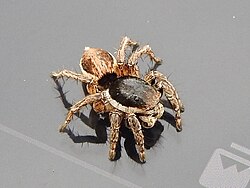Biology:Langona recta
| Langona recta | |
|---|---|

| |
| A spider of the genus Langona | |
| Scientific classification | |
| Domain: | Eukaryota |
| Kingdom: | Animalia |
| Phylum: | Arthropoda |
| Subphylum: | Chelicerata |
| Class: | Arachnida |
| Order: | Araneae |
| Infraorder: | Araneomorphae |
| Family: | Salticidae |
| Subfamily: | Salticinae |
| Genus: | Langona |
| Species: | L. recta
|
| Binomial name | |
| Langona recta Wesołowska & Russell-Smith, 2022
| |
Langona recta is a species of jumping spider in the genus Langona that lives in Ivory Coast. It was first described in 2022 by Wanda Wesołowska and Anthony Russell-Smith. Only the male has been identified. The spider is medium-sized, with a cephalothorax that is typically 4.0 mm (0.16 in) long and an abdomen between 3.0 and 3.5 mm (0.12 and 0.14 in) long. It is hairy and brown, the abdomen lighter than the carapace with a hint of a white streak visible on the back. It has the toothless chelicerae typical of the genus, but, unlike other Langona spiders, has a straight palpal apophysis, or spike, reflected in the species name.
Taxonomy
Langona recta was first described by the arachnologists Wanda Wesołowska and Anthony Russell-Smith in 2022.[1] It was one of over 500 species that Wesołowska has identified, ensuring that she is one of the most prolific describers of jumping spiders to have ever lived.[2] They placed it in the genus Langona, first described by Eugène Simon in 1901[3] The genus was listed in the subtribe Aelurillina in the tribe Aelurillini by Wayne Maddison in 2015. These were allocated to the clade Saltafresia.[4] In 2017, the genus was grouped with nine other genera of jumping spiders under the name Aelurillines. It is particularly closely related to the genus Aelurillus, after which the group is named.[5] The species is named for the Latin word for straight.[6]
Description
The spider is medium-sized and hairy. The male has a cephalothorax that is typically 4.0 mm (0.16 in) long and 2.7 mm (0.11 in) wide. The carapace is brown, shiny and has a dense covering of delicate hairs. The black eye field is short, typically 1.2 mm (0.047 in) long. The chelicerae has short fangs and two very small teeth to the front. The abdomen is between 3.0 and 3.5 mm (0.12 and 0.14 in) long and between 2.1 and 2.3 mm (0.083 and 0.091 in) wide.[7] It is lighter in colour than the carapace and hairy, with the vague suggestion of a white marking on the back.[6] The rear two thirds are covered by a sclerotized scutum. The spider has black hairy legs and dark spinnerets. It has black pedipalps with a white cymbium. The embolus is hidden between the palpal bulb and cymbium, and the palpal apophysis, or spike, is straight, which is reflected in the species name.[8] The female has not been described.[1]
Like other Lagona spiders, the chelicerae are toothless. and there is a single apophysis, or appendage, on the pedipalp tibia, which enables it to be distinguished from other Aelurillinae.[9] The straight palpal apophysis enables it to be identified from other members of the genus.[8]
Distribution and habitat
Langona recta is endemic to Ivory Coast.[1] The holotype was found in 1975 in Lamto Scientific Reserve.[6]
References
Citations
- ↑ 1.0 1.1 1.2 World Spider Catalog (2023). "Langona recta Wesolowska & Russell-Smith, 2022". Natural History Museum. https://wsc.nmbe.ch/species/60704/Langona_recta.
- ↑ Wiśniewski 2020, p. 6.
- ↑ Wesołowska & Russell-Smith 2022, p. 50.
- ↑ Maddison 2015, p. 279.
- ↑ Prószyński 2017, p. 95.
- ↑ 6.0 6.1 6.2 Wesołowska & Russell-Smith 2022, p. 51.
- ↑ Wesołowska & Russell-Smith 2022, p. 52.
- ↑ 8.0 8.1 Wesołowska & Russell-Smith 2022, p. 53.
- ↑ Hęciak & Prószyński 1983, p. 207.
Bibliography
- Hęciak, Stefania; Prószyński, Jerzy (1983). "Remarks on Langona Simon (Araneae, Salticidae)". Annales Zoologici, Warszawa (37): 207–233.
- Maddison, Wayne P. (2015). "A phylogenetic classification of jumping spiders (Araneae: Salticidae)". The Journal of Arachnology 43 (3): 231–292. doi:10.1636/arac-43-03-231-292.
- Prószyński, Jerzy (2017). "Pragmatic classification of the World's Salticidae (Araneae)". Ecologica Montenegrina 12: 1–133. doi:10.37828/em.2017.12.1.
- Wesołowska, Wanda; Russell-Smith, Anthony (2022). "Jumping spiders from Ivory Coast collected by J.-C. Ledoux (Araneae, Salticidae)". European Journal of Taxonomy 841: 1–143. doi:10.5852/ejt.2022.841.1943.
- Wiśniewski, Konrad (2020). "Over 40 years with jumping spiders: on the 70th birthday of Wanda Wesołowska". Zootaxa 4899 (1): 5–14. doi:10.11646/zootaxa.4899.1.3. PMID 33756825.
Wikidata ☰ Q116256110 entry
 |

